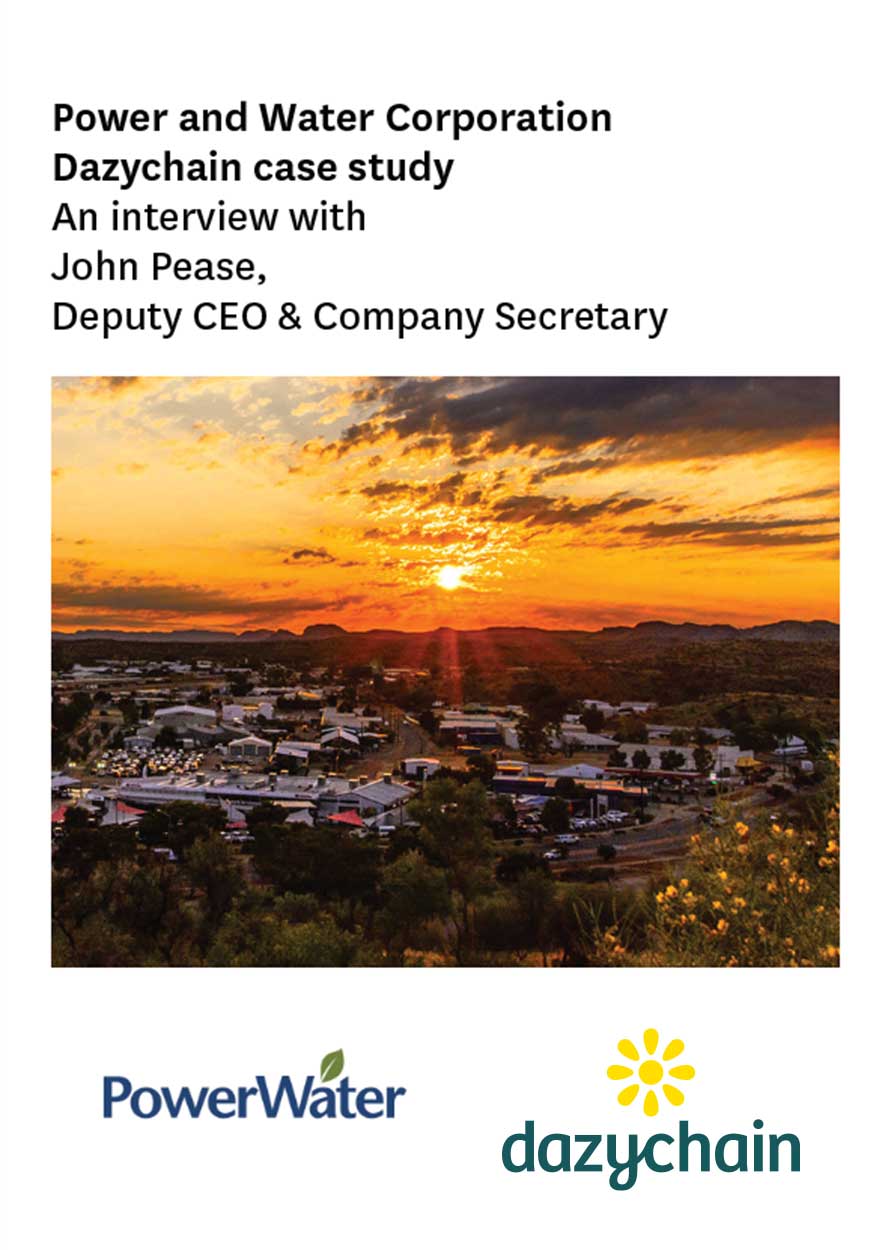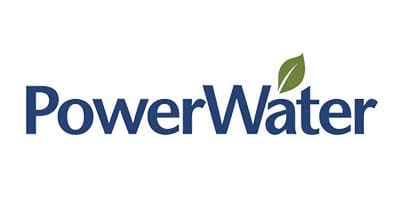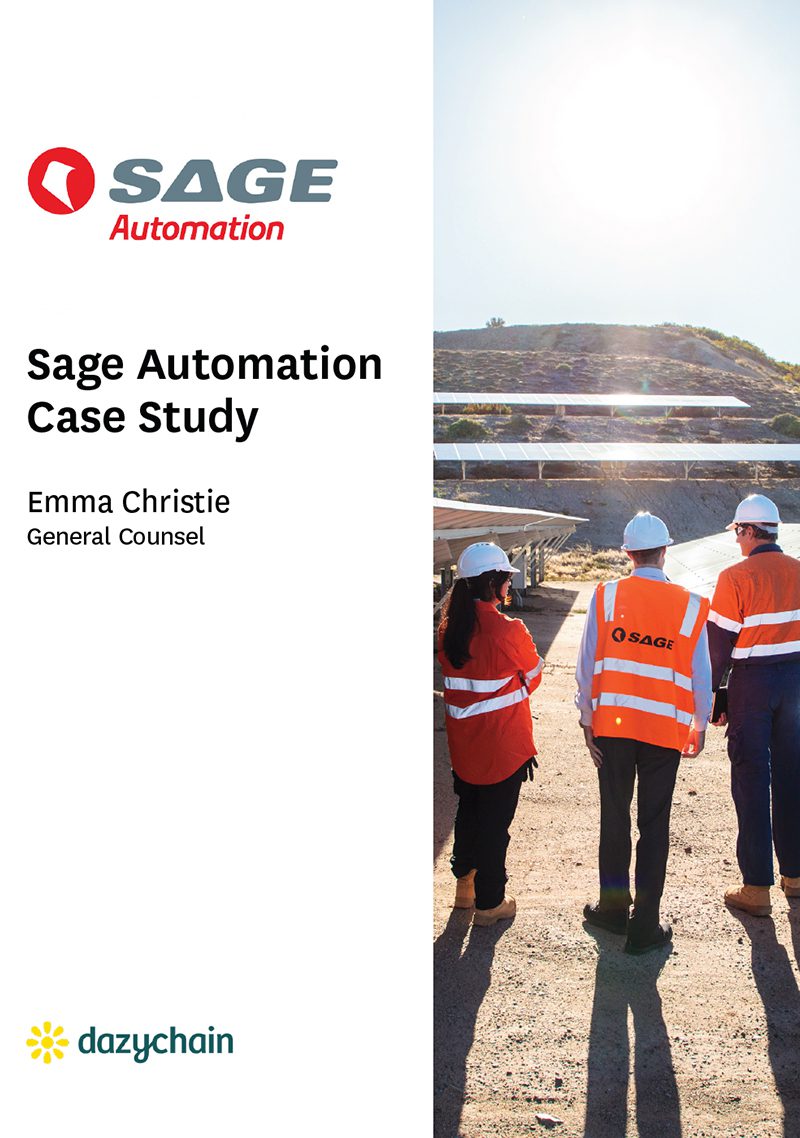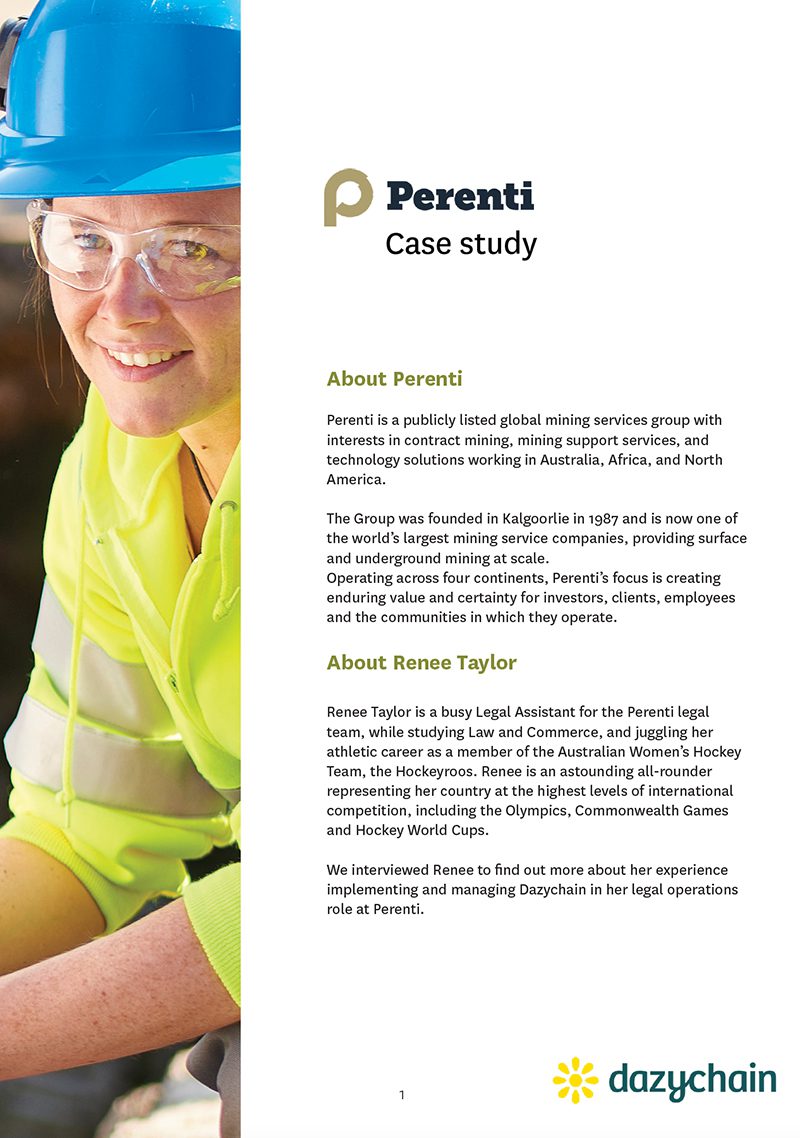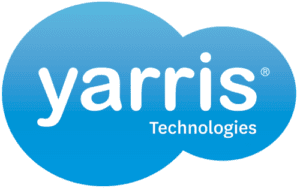An interview with John Pease, Deputy CEO and Company Secretary at Power and Water Corporation
About Power and Water Corporation
“Power and Water is a Northern Territory Government owned corporation providing multi-utility services to each and every one of the 245,000 Territorians spread over the Territory’s vast 1.3 million square kilometre landscape. We employ over 800 Territorians and each year spend over $600 million on goods, works and services with almost 95% of that spend consistently going to local businesses.
We provide electricity network services to around 84,000 homes and businesses and provide potable (or safe drinking) water and sewerage services to around 55,000 homes and businesses. We also provide full water and electricity supplies to 72 remote communities and 79 outstations . Our total asset base is almost $3 billion and anticipate investing more than a further $1 billion over the next decade.
If this isn’t enough we’re also an upstream and downstream gas purchaser and supply, primarily purchasing gas for electricity generation purposes, but also selling the surplus gas acquired to downstream customers in interconnected eastern Australian energy markets.
We’re a complex business with an enormous range of legal questions that come in, from the sublime to the ridiculous and back again, on any day.
But behind the numbers, Power and Water is about people. Everything we do is about people, from our customers to whom we supply essential services every day, the businesses we support to power our economy, the communities we work in, and the people we employ. People are at the centre of everything Power and Water is about.

Responding to climate change
The government in the Northern Territory is committed to 50% renewables on our electricity grid by 2030. The system control and market operating team and the power services team are grappling with what 50% renewables on a historically mono-directional electricity grid looks like and how you integrate that level of renewable energy. In the Northern Territory, renewable energy is primarily solar generated. We don’t get a lot of wind, and when we do, it tends to be pretty cyclonic.
Part of this transition to renewables includes how we can safely connect large-scale solar farms on the grid. A few years ago, we introduced generator performance standards which are, essentially, the conditions that new, large-scale solar farms must satisfy before we can connect them to the grid safely and without impacting system security.
The legal team has helped with drafting these standards, including issues around the role of the system control, particularly as the government is keen to introduce more competition into our market. We’re working out the role of the system control and market team in a complex environment, where previously electricity generation was provided by government-owned organizations. We had to provide advice, for example, on the legislative basis for a system control team to issue directions and whether that should be at a legislative Act level or at a regulatory level.
The Power and Water team
We’ve grown from what was a team of one into now a team of two. So we’ve increased our size by 100%, as I like to say! The team also comprises two secondees from external law firms to assist us with our work, and we also rely on our external legal panel to provide legal support to the business.
Originally there were plans to bring in specialist lawyers, so an electricity expert, a gas expert, but on reflection, including the realities of attracting and retaining those specialist skills in our environment, I took the view that we’re far better off having a team of experienced generalists who can pretty much handle anything and are good at managing external firms and making the right choices in where we allocate work.
The team that we’ll build out will probably have another couple of lawyers with that five-to-seven-year range of experience, people who have worked preferably in-house and understand the pressures of having the client right at your front doorstep, or just across the partition divider and can work with that. As I often describe it, it’s the challenge of having 10 plates on sticks and keeping them all spinning in the air at any one time.



Why we chose Dazychain
There were a range of reasons we purchased Dazychain. First, it was a flexible system and gave us a lot of configuration options, so that out of the box we could configure it to the way we worked as much as possible.
Second, a key thing for us as a government-owned enterprise was the ability to easily download the contents of any matter and then create a zip file from it, so that we could then comply with our records management obligations. So that was another one of our key criteria.
Third, the intuitive nature of Dazychain and its ease of use was also a key deciding factor, not that we have any black letter lawyers, but we needed it to be easy to use, so somebody who would still be comfortable with a quill pen and a bottle of ink could adapt to using the system as much as somebody who lives their life on a tablet, kind of environment.
The other thing for me, and I know we haven’t really tapped into this yet, is that functionality of the front-end bot for our legal intake we’re planning next.
The Dazychain team has been very responsive, and so having somebody that you can just ring up and you get things fixed on the fly has been a real positive from my perspective.
Creating and sharing reports
I’m able to use Dazychain proficiently now, whereas previously I was exporting Excel spreadsheets and having to manipulate the data. I can now get my significant claims register directly from Dazychain. I can still export it as a spreadsheet so I can convert charts, but it gives me that functionality.



The search function leverages previous work
I can find matters quickly now using the search functionality. It is very powerful and easy to use. I can access Dazychain from home or work. It gives me more flexibility around working as well, and I know the team members find that helpful as well.
Particularly for us, what we tended to do previously was, every time a new instruction came in, we’d open a new matter. Dazychain gives me the ability to quickly search and identify whether we’ve already looked at something similar (or the same), and so instead of opening a new matter, we just open an extension of the existing matter or leverage the work that was previously done.
A lot of our work relates to requested departures on procurement tenders and other types of historical matters, and so simply going back and looking at the last one that the same vendor requested, you don’t have to reinvent the wheel, you just refer to the earlier advice and say, “Well, that’s the advice we gave you when they asked to change that clause or remove that clause. The position hasn’t changed. Just make a call that’s consistent with that.” We’re finding we can frequently reuse advice and save money on our external spend.
Using dashboards to manage the team’s work allocation
We produce a monthly performance report for the business, and so I’ll look at the dashboards to see how work is spread across the team, or across the individual member, or how work is spread across the external firms that we use.
What I like about the dashboards is you can zero in very quickly. I also use it to do a bit of QA to make sure the team are completing the right details when they open new matters, because we want people to embrace creating matters in Dazychain as much as possible.
I can pick up issues very quickly using the dashboards, to see which matters aren’t complete with details such as an allocated risk rating or strategic alignment. I’ll look at a dashboard and they’ll tell me there’s five unassigned matters, and so I just edit and allocate reputation rating or effort required, so that our database is always complete.
I’ll always make a point of following up with individual team members to remind them why it’s important to provide this data. Data gaps are getting smaller and smaller as time goes on.
Occasionally I’ll find an orphaned project, where someone hasn’t opened the matter from one of our folders and, once again, the system’s very quick to identify those kinds of aberrations so our data is always current.


Gathering matter data
The data we gather certainly impacts incoming matters. It gives me the ability to quickly see if the work relates to a particular type of licence or area of law. I can see who’s doing most of that work. It helps me make work allocation choices.
Ultimately, I’d like to use Dazychain to see how we are spreading work between the different external firms and keeping a balance on that, and certainly avoiding outsourcing work where we’ve recently received similar type advice and, so we can leverage advice that we’ve bought already.
Reusing advice
If something’s more than four years old, you’d probably say it’s too dated and you’d want to get up-to-date advice anyway, but if we only received advice six months ago or 12 months ago, you’d probably say, “Well, nothing’s really changed. Let’s look at what we did last time.”
Most law firms are quick to turn matters around. The good thing is, with the workflow and the Dazychain alerts, if a response isn’t back within the 48 hour or two business days that we’ve nominated, it creates a prompt to follow up.
Dazychain is flexible
I recommend Dazychain to other teams. It’s a flexible tool. I can see it has a lot of power, and it’s a function of how much time you dedicate to using it. I spend an hour here, an hour there, when I’m tinkering around the edges when I’m not doing other work.
I also like how the Dazychain team is prepared to take on board our requests for changes and updates.



Knowledge management advice for teams embarking on the matter management software journey
I recommend that users are disciplined about matter and document file names to create an orderly knowledge management approach. It’s a simple thing, but when you have a matter that ends up with lots of attachments or documents, if you don’t have discipline with how you name the documents, it’s harder to find the documents you need.
As a user, I prefer to be able to sort documents in time-based order. Our team agreed that any documents will have the date in reverse order (YYMMDD) so we can automatically sort them by date, and we give a name to the document that is at least half meaningful to somebody who may not be familiar with it. The Dazychain team helped us with document naming convention approaches.
The team needs to be really disciplined in their approach, understanding that the value of data is only as good as the quality of the data that you put in. It’s that old saying: “Garbage in, garbage out.” If you’re not going to have that discipline upfront, you might as well just dump it all in Explorer and use an Excel spreadsheet, because you’re not going to get any more benefit out of a system if you haven’t got that discipline.
I have a pretty good grip on Dazychain now. I’ve certainly learned about ‘thinking backwards’ and it’s reinforced through use of Dazychain. So, I consider what I want to get out of the system, and work backwards from that, because that then tells me what fields I need to capture or how I need to structure the data, because that then will flow through to the reports or the dashboards.
Launching Dazychain
For our team, the transition was pretty smooth. Dazychain was great – and very present – in providing on-boarding training for everyone in the team. Ultimately, we got to a point that we were as prepared as we could be, and I then just said, “Right. We’re pushing off from the wharf and we’ll make it work.” I think you can plan and organize these things to death but, sooner or later, you’ve just got to take that scary step off the cliff and hope the parachute opens when you pull the cord.”
Interested in discussing Dazychain solutions?
An interview with John Pease, Deputy CEO and Company Secretary at Power and Water Corporation
John Pease
General Counsel
Power and Water Corporation
About Power and Water Corporation
“Power and Water is a Northern Territory Government owned corporation providing multi-utility services to each and every one of the 245,000 Territorians spread over the Territory’s vast 1.3 million square kilometre landscape. We employ over 800 Territorians and each year spend over $600 million on goods, works and services with almost 95% of that spend consistently going to local businesses.
We provide electricity network services to around 84,000 homes and businesses and provide potable (or safe drinking) water and sewerage services to around 55,000 homes and businesses. We also provide full water and electricity supplies to 72 remote communities and 79 outstations . Our total asset base is almost $3 billion and anticipate investing more than a further $1 billion over the next decade.
If this isn’t enough we’re also an upstream and downstream gas purchaser and supply, primarily purchasing gas for electricity generation purposes, but also selling the surplus gas acquired to downstream customers in interconnected eastern Australian energy markets.
We’re a complex business with an enormous range of legal questions that come in, from the sublime to the ridiculous and back again, on any day.
But behind the numbers, Power and Water is about people. Everything we do is about people, from our customers to whom we supply essential services every day, the businesses we support to power our economy, the communities we work in, and the people we employ. People are at the centre of everything Power and Water is about.



Responding to climate change
The government in the Northern Territory is committed to 50% renewables on our electricity grid by 2030. The system control and market operating team and the power services team are grappling with what 50% renewables on a historically mono-directional electricity grid looks like and how you integrate that level of renewable energy. In the Northern Territory, renewable energy is primarily solar generated. We don’t get a lot of wind, and when we do, it tends to be pretty cyclonic.
Part of this transition to renewables includes how we can safely connect large-scale solar farms on the grid. A few years ago, we introduced generator performance standards which are, essentially, the conditions that new, large-scale solar farms must satisfy before we can connect them to the grid safely and without impacting system security.
The legal team has helped with drafting these standards, including issues around the role of the system control, particularly as the government is keen to introduce more competition into our market. We’re working out the role of the system control and market team in a complex environment, where previously electricity generation was provided by government-owned organizations. We had to provide advice, for example, on the legislative basis for a system control team to issue directions and whether that should be at a legislative Act level or at a regulatory level.
The Power and Water team
We’ve grown from what was a team of one into now a team of two. So we’ve increased our size by 100%, as I like to say! The team also comprises two secondees from external law firms to assist us with our work, and we also rely on our external legal panel to provide legal support to the business.
Originally there were plans to bring in specialist lawyers, so an electricity expert, a gas expert, but on reflection, including the realities of attracting and retaining those specialist skills in our environment, I took the view that we’re far better off having a team of experienced generalists who can pretty much handle anything and are good at managing external firms and making the right choices in where we allocate work.
The team that we’ll build out will probably have another couple of lawyers with that five-to-seven-year range of experience, people who have worked preferably in-house and understand the pressures of having the client right at your front doorstep, or just across the partition divider and can work with that. As I often describe it, it’s the challenge of having 10 plates on sticks and keeping them all spinning in the air at any one time.



Why we chose Dazychain
There were a range of reasons we purchased Dazychain. First, it was a flexible system and gave us a lot of configuration options, so that out of the box we could configure it to the way we worked as much as possible.
Second, a key thing for us as a government-owned enterprise was the ability to easily download the contents of any matter and then create a zip file from it, so that we could then comply with our records management obligations. So that was another one of our key criteria.
Third, the intuitive nature of Dazychain and its ease of use was also a key deciding factor, not that we have any black letter lawyers, but we needed it to be easy to use, so somebody who would still be comfortable with a quill pen and a bottle of ink could adapt to using the system as much as somebody who lives their life on a tablet, kind of environment.
The other thing for me, and I know we haven’t really tapped into this yet, is that functionality of the front-end bot for our legal intake we’re planning next.
The Dazychain team has been very responsive, and so having somebody that you can just ring up and you get things fixed on the fly has been a real positive from my perspective.
Creating and sharing reports
I’m able to use Dazychain proficiently now, whereas previously I was exporting Excel spreadsheets and having to manipulate the data. I can now get my significant claims register directly from Dazychain. I can still export it as a spreadsheet so I can convert charts, but it gives me that functionality.



The search function leverages previous work
I can find matters quickly now using the search functionality. It is very powerful and easy to use. I can access Dazychain from home or work. It gives me more flexibility around working as well, and I know the team members find that helpful as well.
Particularly for us, what we tended to do previously was, every time a new instruction came in, we’d open a new matter. Dazychain gives me the ability to quickly search and identify whether we’ve already looked at something similar (or the same), and so instead of opening a new matter, we just open an extension of the existing matter or leverage the work that was previously done.
A lot of our work relates to requested departures on procurement tenders and other types of historical matters, and so simply going back and looking at the last one that the same vendor requested, you don’t have to reinvent the wheel, you just refer to the earlier advice and say, “Well, that’s the advice we gave you when they asked to change that clause or remove that clause. The position hasn’t changed. Just make a call that’s consistent with that.” We’re finding we can frequently reuse advice and save money on our external spend.
Using dashboards to manage the team’s work allocation
We produce a monthly performance report for the business, and so I’ll look at the dashboards to see how work is spread across the team, or across the individual member, or how work is spread across the external firms that we use.
What I like about the dashboards is you can zero in very quickly. I also use it to do a bit of QA to make sure the team are completing the right details when they open new matters, because we want people to embrace creating matters in Dazychain as much as possible.
I can pick up issues very quickly using the dashboards, to see which matters aren’t complete with details such as an allocated risk rating or strategic alignment. I’ll look at a dashboard and they’ll tell me there’s five unassigned matters, and so I just edit and allocate reputation rating or effort required, so that our database is always complete.
I’ll always make a point of following up with individual team members to remind them why it’s important to provide this data. Data gaps are getting smaller and smaller as time goes on.
Occasionally I’ll find an orphaned project, where someone hasn’t opened the matter from one of our folders and, once again, the system’s very quick to identify those kinds of aberrations so our data is always current.


Gathering matter data
The data we gather certainly impacts incoming matters. It gives me the ability to quickly see if the work relates to a particular type of licence or area of law. I can see who’s doing most of that work. It helps me make work allocation choices.
Ultimately, I’d like to use Dazychain to see how we are spreading work between the different external firms and keeping a balance on that, and certainly avoiding outsourcing work where we’ve recently received similar type advice and, so we can leverage advice that we’ve bought already.
Reusing advice
If something’s more than four years old, you’d probably say it’s too dated and you’d want to get up-to-date advice anyway, but if we only received advice six months ago or 12 months ago, you’d probably say, “Well, nothing’s really changed. Let’s look at what we did last time.”
Most law firms are quick to turn matters around. The good thing is, with the workflow and the Dazychain alerts, if a response isn’t back within the 48 hour or two business days that we’ve nominated, it creates a prompt to follow up.
Dazychain is flexible
I recommend Dazychain to other teams. It’s a flexible tool. I can see it has a lot of power, and it’s a function of how much time you dedicate to using it. I spend an hour here, an hour there, when I’m tinkering around the edges when I’m not doing other work.
I also like how the Dazychain team is prepared to take on board our requests for changes and updates.



Knowledge management advice for teams embarking on the matter management software journey
I recommend that users are disciplined about matter and document file names to create an orderly knowledge management approach. It’s a simple thing, but when you have a matter that ends up with lots of attachments or documents, if you don’t have discipline with how you name the documents, it’s harder to find the documents you need.
As a user, I prefer to be able to sort documents in time-based order. Our team agreed that any documents will have the date in reverse order (YYMMDD) so we can automatically sort them by date, and we give a name to the document that is at least half meaningful to somebody who may not be familiar with it. The Dazychain team helped us with document naming convention approaches.
The team needs to be really disciplined in their approach, understanding that the value of data is only as good as the quality of the data that you put in. It’s that old saying: “Garbage in, garbage out.” If you’re not going to have that discipline upfront, you might as well just dump it all in Explorer and use an Excel spreadsheet, because you’re not going to get any more benefit out of a system if you haven’t got that discipline.
I have a pretty good grip on Dazychain now. I’ve certainly learned about ‘thinking backwards’ and it’s reinforced through use of Dazychain. So, I consider what I want to get out of the system, and work backwards from that, because that then tells me what fields I need to capture or how I need to structure the data, because that then will flow through to the reports or the dashboards.
Launching Dazychain
For our team, the transition was pretty smooth. Dazychain was great – and very present – in providing on-boarding training for everyone in the team. Ultimately, we got to a point that we were as prepared as we could be, and I then just said, “Right. We’re pushing off from the wharf and we’ll make it work.” I think you can plan and organize these things to death but, sooner or later, you’ve just got to take that scary step off the cliff and hope the parachute opens when you pull the cord.”
